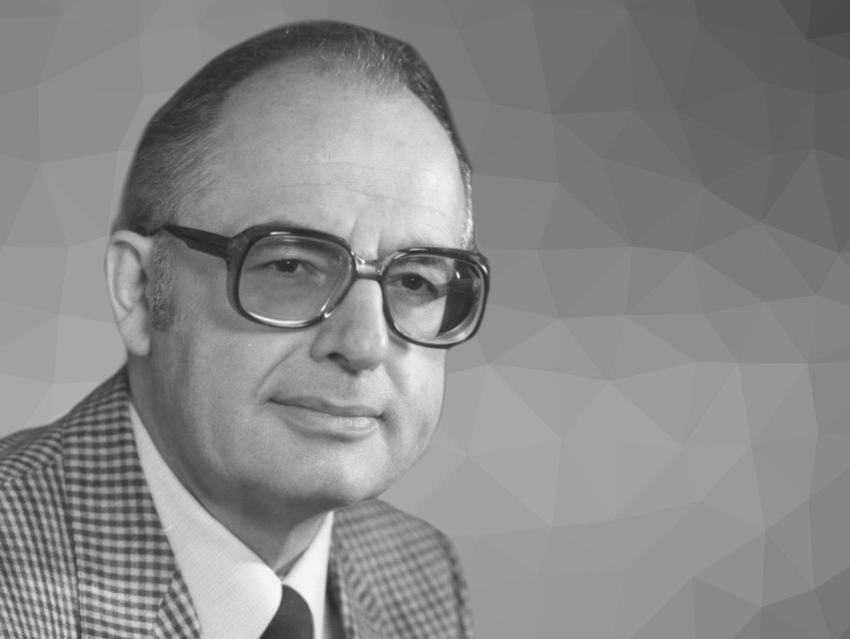Professor Albert Jakob Eschenmoser, Swiss Federal Institute of Technology (ETH) Zurich, Switzerland, passed away peacefully at the age of 97 on July 14, 2023. His university describes him as a “brilliant mind” who has “shaped organic chemistry as did few others”.
He is best known for his work on the synthesis of complex heterocyclic natural compounds, especially vitamin B12. His work led to remarkable achievements in total synthesis, and he made significant contributions to developing synthetic methods and uncovering fundamental mechanisms in biosynthesis and organic chemistry.
Eschenmoser was engaged in various areas of organic and bioorganic chemistry in his research, including terpene biosynthesis, the mechanism and stereochemistry of organic and biochemical reactions, the development of new reactions and methods for organic synthesis, the structure elucidation and total synthesis of complex natural products, the chemistry of hydroporphinoid ligand systems (ligands that can bind to metal ions in biological systems), the origins and structure of vitamin B12 [1], the chemical reasons for nucleic acid structures [2,3], and finally, problems in prebiotic chemistry [4].
Eschenmoser’s name will live on, e.g., in the Eschenmoser–Claisen rearrangement, in which allylic alcohols are converted into γ,δ-unsaturated amides in the presence of N,N-dimethylacetamide dimethyl acetal [5,6], the Eschenmoser fragmentation, a reaction of α,β-epoxyketones with aryl sulfonylhydrazines to give alkynes and carbonyl compounds [7,8], in Eschenmoser’s salt, which is the iodide salt of the dimethylaminomethylene cation [(CH3)2N=CH2]+ [9], and in the Eschenmoser sulfide contraction, a transformation of thioesters to 1,3-dicarbonyl compounds [10].
Albert Jakob Eschenmoser, born on August 5, 1925, in Erstfeld, Switzerland, studied natural sciences with a major in chemistry at ETH Zurich. In 1949, he received his diploma (dipl. sc. nat. ETH). He completed his doctoral degree (D. Sci.) in 1951 at the institute of Leopold Ruzicka within the research group of Hans Schinz. Ruzicka supported Eschenmoser in furthering the research initiated during his doctoral thesis by allowing him to lead his own group of doctoral students.
In 1956, Eschenmoser became Privatdozent in Organic Chemistry at ETH Zurich. He was promoted to Associate Professor in 1960 and to Full Professor for General Organic Chemistry there in 1965. After his retirement in 1992, he continued to conduct research on a small scale, collaborating with postdoctoral students at various institutes, including the Biozentrum of the University of Frankfurt am Main, Germany, and the Scripps Research Institute in La Jolla, CA, USA.
Among many other honors, Albert Eschenmoser was a Member of the German National Academy of Sciences Leopoldina, the Academia Europaea, and the Pontifical Academy, a Foreign Member of the American Academy of Arts and Sciences, the U.S. National Academy of Sciences, the Royal Society, UK, the Göttingen Academy of Sciences and Humanities, and the Croatian Academy of Sciences and Arts. He was an Honorary Member of the Royal Society of Chemistry (RSC), the Austrian Chemical Society (Gesellschaft Österreichischer Chemiker, GÖCH), and the Pharmaceutical Society of Japan. He held honorary degrees from the Universities of Fribourg, Switzerland, Chicago, IL, USA, Edinburgh, UK, Bologna, Italy, Frankfurt am Main, Germany, Strasbourg, France, Harvard University, MA, USA, and the Scripps Research Institute. He received the German Order of Merit (Pour le Mérite) for Sciences and Arts, the Austrian Decoration for Science and Art, and the Paul Karrer Medal in 2008.
References
[1] Vitamin B12: Experiments Concerning the Origin of Its Molecular Structure,
A. Eschenmoser,
Angew. Chem. Int. Ed. 1988.
https://doi.org/10.1002/anie.198800051
[2] Chemical Etiology of Nucleic Acid Structure: The α-Threofuranosyl-(3’→2′) Oligonucleotide System,
K.-U. Schöning, P. Scholz, S. Guntha, X. Wu, R. Krishnamurthy, A. Eschenmoser,
Science 2000, 290, 1347–1351.
https://doi.org/10.1126/science.290.5495.1347
[3] Chemical Etiology of Nucleic Acid Structure,
A. Eschenmoser,
Science 1999, 284, 2118–2124.
https://doi.org/10.1126/science.284.5423.2118
[4] The Search for the Chemistry of Life’s Origin,
A. Eschenmoser,
Tetrahedron 2007, 63(52), 12821–12844.
https://doi.org/10.1016/j.tet.2007.10.012
[5] Claisen’sche Umlagerungen bei Allyl- und Benzylalkoholen mit Hilfe von Acetalen des N,N-Dimethylacetamids. Vorläufige Mitteilung,
A. E. Wick, Dorothee Felix, Katharina Steen, A. Eschenmoser,
Helv. Chim. Acta 1964, 47, 2425–2429.
https://doi.org/10.1002/hlca.19640470835
[6] Claisen’sche Umlagerungen bei Allyl- und Benzylalkoholen mit 1-Dimethylamino-1-methoxy-äthen,
D. Felix, K. Gschwend-Steen, A. E. Wick, A. Eschenmoser,
Helv. Chim. Acta 1969, 52, 1030–1042.
https://doi.org/10.1002/hlca.19690520418
[7] Eine neuartige Fragmentierung cyclischer α,β-ungesättigter Carbonylsysteme; Synthese von Exalton und rac-Muscon aus Cyclododecanon Vorläufige Mitteilung,
A. Eschenmoser, D. Felix, G. Ohloff,
Helv. Chim. Acta 1967, 50, 708–713.
https://doi.org/10.1002/hlca.19670500232
[8] Die Synthese von Acetylen-carbonyl-Verbindungen durch Fragmentierung von α,β-Epoxy-ketonen mit p-Toluolsulfonylhydrazin. Vorläufige Mitteilung,
J. Schreiber, D. Felix, A. Eschenmoser, M. Winter, F. Gautschi, K. H. Schulte-Elte, E. Sundt, G. Ohloff, J. Kalovoda, H. Kaufmann, P. Wieland, G. Anner,
Helv. Chim. Acta 1967, 50, 2101–2108.
https://doi.org/10.1002/hlca.19670500747
[9] Dimethyl(methylene)ammonium Iodide,
J. Schreiber, H. Maag, N. Hashimoto, A. Eschenmoser,
Angew. Chem. Int. Ed. Engl. 1971, 10, 330–331.
https://doi.org/10.1002/anie.197103301
[10] Sulfidkontraktionviaalkylative Kupplung: Eine methode zur darstellung von β-dicarbonylderivaten. Über synthetische methoden, 1. Mitteilung,
M. Roth, P. Dubs, E. Götschi, A. Eschenmoser,
Helv. Chim. Acta 1971, 54, 710–734.
https://doi.org/10.1002/hlca.19710540229
Other Selected Publications
Zur Kenntnis der Triterpene. 190. Mitteilung. Eine stereochemische Interpretation der biogenetischen Isoprenregel bei den Triterpenen,
A. Eschenmoser, L. Ruzicka, O. Jeger, D. Arigoni,
Helv. Chim. Acta 1955, 38, 1890–1904.
https://doi.org/10.1002/hlca.19550380728
Evidence for Antibody-Catalyzed Ozone Formation in Bacterial Killing and Inflammation,
P. Wentworth, Jr., J. E. McDunn, A. D. Wentworth, C. Takeuchi, J. Nieva, T. Jones, C. Bautista, J. M. Ruedi, A. Gutierrez, K. D. Janda, B. M. Babior, A.Eschenmoser, R. A. Lerner,
Science 2002, 298, 2195–2199
https://doi.org/10.1126/science.1077642
Eine Stereochemische Interpretation der biogenetischen Isoprenregel bei den Triterpenen,
A. Eschenmoser,
Helv. Chim. Acta 1955, 38, 1890.
https://doi.org/10.1002/hlca.19550380728
Also of Interest
„Erfolgsmomente in der Forschung sind ausserordentlich lustvoll!“ (Interview with Albert Eschenmoser),
L. Weber,
Chimia 2010, 64, 323–327.
https://doi.org/10.2533/chimia.2010.323
More on Leopold Ružička:
The Licorice Wheel,
K. Roth,
ChemistryViews 2023.
https://doi.org/10.1002/chemv.202300019
Pyrethrum: History of a Bio-Insecticide,
K. Roth, E. Vaupel,
ChemistryViews 2018.
https://doi.org/10.1002/chemv.201800089



